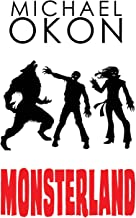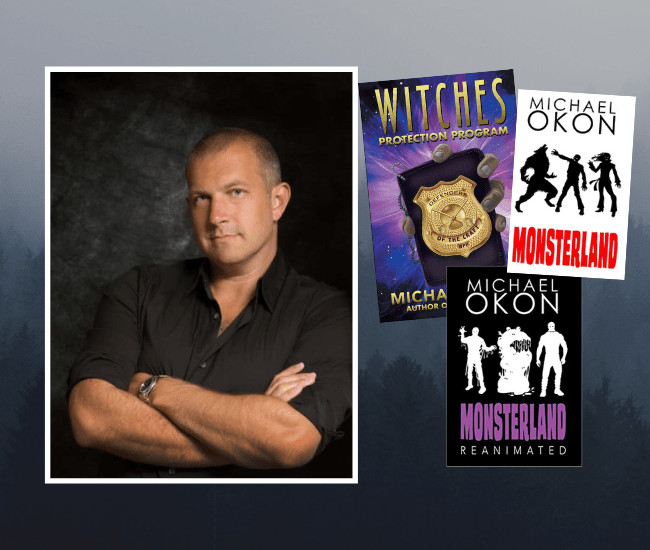Monsterland
This is nothing like your standard fare. An amusement park with monsters (Monsterland)? A society in which witches live among the masses but carry special powers (Witches Protection Program)? Welcome to the world of author Michael Okon, where unusual characters, venues and situations are the norm.
Okon is an award-winning and bestselling author whose work spans several genres: paranormal, thriller, horror, action/adventure and even self-help. From the time he saw the movie Goonies, he has been hooked on the idea of entertaining people through unforgettable stories.
Following the recent re-release of Witches Protection Program, BookTrib caught up with the author to discuss his work and where his ideas come from.
BookTrib: An agency that protects witches. A demon holding a dead wife’s spirit hostage. A theme park where you can interact with real monsters. Where do you come up with this stuff?
Michael Okon: Movies. I love taking an existing idea and mashing it up. I pitched my book Brood X to a mega producer years ago — my version of The Birds, but with bugs. They loved it, but not enough to buy the rights. They said they were looking for something more like Taken with Liam Neeson.
That got my mind thinking. I figured why not put a paranormal twist on a classic tale, and the idea of Stillwell was born. Monsterland was simply me watching Jurassic Park with my kids and I literally just asked, “Why isn’t there a theme park with monsters?” Hollywood has a rule – give me the same thing, but make it different. That’s exactly what I do with all my stories.
Your work exhibits a fascination with paranormal thrillers and horror. How did you gravitate to these subjects?
I’m a huge believer in spirituality and the afterlife. I firmly believe we are souls having a human experience. The evidence of this is too overwhelming. If that’s the case, and we are just wearing these “meat suits” for a limited time on earth, that opens us up to unlimited possibilities as to who we are.
Focusing on paranormal allows me to play in the spiritual sandbox about what exists beyond the grave. Do we carry our personalities with us when we cross over? What’s the point of learning things as a human? These are questions that cross my mind all day. And when you add in a touch of horror, it makes for a page-turning read. Paranormal and horror go hand-in-hand like meat and potatoes.
Witches Protection Program has been described as “a tongue-in-cheek alternate reality where witches cast spells and wreak havoc in modern day New York City.” I have to admit I thought you came up with the title first and then decided to write a book around it. How did you come up with the title and what are the origins of the story itself?
This is a bit embarrassing. I was in the bathroom one evening and turned to a pile of my wife’s trashy pop magazines. It was upside down and I read a caption that I thought said Witches Protection Program. I went, “wow, that’s a great book title.” I picked up the magazine and it said Wetless Protection Program. I had NO CLUE what they were trying to caption, but the idea of a government agency that protected witches was born that very second.
Witches Protection Program reminded me of the TV show True Blood. In True Blood, vampires are part of society and interact with humans. In Witches Protection Program, witches are all over the place, seemingly in normal jobs doing normal things. How did you construct this book to make witches appear normal and a part of society?
I’ve never seen True Blood, but I am a familiar with the concept. The quick answer is this: I tend to drive a lot, and when I’m driving, I’m always wondering if that person I just passed is a werewolf or witch. It literally is that simple. If I watch TV, and I see some powerful politician yammering about something, I’m curious to know if they belong to a cult of warlocks. This is what drives my wife nuts.
When you talk about witches, or, in your other books, spirits or monsters, does that give you license to make up situations as you go along without needing to conform to rules or boundaries?
Every one story I write, the first thing I put down on is the rules of that universe. I will never just write and figure it out from there. I have to know the sandbox my characters are playing in. The rules are mine because it’s my story, but I try to keep true to the folklore of that creature.
For example, in Monsterland, I basically humanize the monsters and monsterize the humans. The vampires are not blood-sucking monsters. They are humans that crave blood through a sexually transmitted disease. You can get bit by a vampire, but you won’t become a vampire. It’s when you have a one-night stand with an actual vamp, then you will become one.
Same the werewolves. Werewolves are terrorizing creatures in folklore that come out during full moons and feast on humans. I made the werewolves more benign. More victims then villains. They escaped their towns and live remotely in the Everglades, feasting on alligators. My werewolves don’t want to harm humans because they are human. People can identify with my characters, because I have a familiar yet very different set of rules for each of them.
Is there some overarching message in your work about people being placed in scary situations to help them overcome their fears? Or is it all just for fun?
There is always a message in my works; however, there are three essential elements in a standard “Monster in the House” story that must be there to make the story relatable and able to work. We need a monster. That’s a given. Some vicious, misunderstood thing that wants to eat/kill/maim the main characters. We need a house. A place where our beloved heroes cannot leave. They cannot say “Check please!” and take the train to the next town. And finally, in order for the monster to be unleashed, we need a sin. Perfect example, the sin in Jaws is keeping the beaches open during 4th of July week to make money, knowing there’s a killer shark in the water. The shark wouldn’t kill if our players did the right thing and closed the damn beaches. I use these three elements to tell a classic horror story. Nothing is just for fun.
Your books are relatively short, yet they carry out brisk, compelling storylines from beginning to end. Why did you choose a shorter format for your novels?
I can’t write an 800-page novel with 50 pages of that describing a door. I believe we are in an age where short content is king. Most people don’t have time or patience to read huge, drawn out novels. But if you want entertainment for a few nights, then yes, I think a 200-page book is perfect.
Does the shorter length affect your ability to develop characters?
Character development is key, but I feel the character arc is more important. It’s easy to say where a character has come from, what makes them tick, what fears they have. However, I want to know how this character is going to overcome those fears. What obstacles can I put in their way, and how the hell are they going to get out of it? It’s easy to go deep into character and get lost by never getting to the point. But explaining a few pages about the character’s past then testing that character in a ridiculous setting is what makes them develop into the hero we are reading about.
You are a lifelong movie buff. What movies have been influential to you in your writing?
Here area few in no particular order: The Goonies, Back to the Future, There Will Be Blood, Lord of the Rings, Empire Strikes Back, Rounders, Jurassic Park, Inglorious Basterds, Pulp Fiction, Django Unchained, Reservoir Dogs, Moana, Monsters Inc., Tremors, Jaws, Creature from the Black Lagoon, Dracula, Frankenstein, Gremlins, The Shining, 2001: A Space Odyssey, Willy Wonka and the Chocolate Factory, The Magnificent Seven, and Indiana Jones.
Any new books in the works?
I’m working on a new book called Inheritance. A young girl is invited to her dead billionaire uncle’s will reading, and the inheritance is not what anyone would expect.
Witches Protection Program is now available for purchase.
Buy this Book!
Amazon





